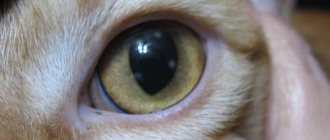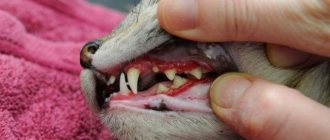Sarcoprosis in cats is a very serious disease that requires qualified treatment. The sick animal suffers greatly and may even die if there is no veterinary care. Our article will tell you how to identify the disease and what to do to speed up the recovery of a tick-infected pet.
You can see what cats look like after contracting sarcoptic mites in the photo.
What is sarcoptic mange
Sarcoptic mange (itching scabies) is a disease caused by itch mites belonging to the genus Sarcoptes.
A quick glance is enough to understand that an animal is affected by a tick mite. Even a person who has nothing to do with veterinary medicine, looking at a sick pet, can easily guess that it was attacked by ticks. The spectacle is truly memorable - like an episode from a horror film, which you only need to watch once and you will remember it for the rest of your life.
At the very beginning of the disease, the itch mite affects the muzzle, forehead and wings of the nose, but quickly spreads throughout the body. The parasites that have settled in the thickness of the epidermis become a source of severe itching, which torments the cat day and night, not giving a moment of rest. The unfortunate animal practically does not sleep, loses its appetite, and suffers from physical and nervous exhaustion.
The appearance of sick animals also undergoes significant changes: the body becomes covered with extensive bald patches, and scabs and scabs form in place of numerous scratches. When they fall off, ulcers and erosions become noticeable on the exposed areas of skin.
Due to constant trauma to the skin, the animal’s already exhausted body becomes especially susceptible to various types of infections. Fungi and bacteria, encountering no resistance, attack the sufferer and, if immediate help is not provided, he will soon die.
Is the itch mite dangerous for humans?
Let us hasten to reassure cat owners, especially those who have small children: sarcoptic mange poses no danger to humans. Even if mites somehow get onto your skin, nothing bad will happen: outside the cat’s body, the parasites do not multiply and quickly die. If you have a slightly lowered immune system (for example, due to a recent cold), after contact with a tick you may experience redness or mild itching, which will disappear after a few days. Most people do not experience these symptoms either.
The itch mite is also not dangerous for children. Just try to protect your sick pet from children: Sarcoptes can cause an allergic reaction in them. Nature, however, made sure that small children avoid contact with a sick animal: its appearance is truly terrible, so that a child would rather run away from his pet crying than try to pet it.
Diagnosis of scabies
If you suspect your cat has scabies, it is important to seek veterinary help promptly. The clinic will help make an accurate diagnosis and prescribe adequate treatment. Diagnostics includes an external examination of the animal and taking skin scrapings for microscopic analysis. This procedure is repeated two or three times to confirm the output. Based on the results, the doctor makes a conclusion about the cause of the problem. Often, a mite infestation can be confused with dermatitis, an allergic reaction, ringworm, or eczema. Therefore, a laboratory test is mandatory in the diagnostic system.
The duration of therapy is determined by the severity of the disease and the condition of the pet itself. The average treatment period for scabies ranges from one to four weeks. Medical care for a pet consists of injections, ointments, solutions, drops, and hygiene products with a therapeutic effect (shampoos, soaps). To eliminate scabies in cats, acaricides, antibiotics, antihistamines, antiseptics, and immunomodulators are used. To prevent the cat from licking the ointment applied to the surface of the skin, it is necessary to use a protective cap.
Symptoms
It will not be possible to immediately know that your pet has been attacked by a tick mite. During the first two or three weeks, no external changes are observed. However, during this period, symptoms may appear that should alert you.
Signs of a cat being infected with sarcoptic mange:
- blisters near the nose and ears, formation of papules;
- papules on the face, which gradually turn into crusts;
- severe itching;
- hair loss in the affected area;
- sores on the skin.
The first alarming signs of infection can be noted only on the tenth day of the disease.
How does the disease manifest?
The development of the disease begins with the appearance of lesions on the cat’s head and ears. Gradually, the parasites manifest themselves in other parts of the body. The disease is accompanied by the following symptoms: 1. Constant itching. Parasites constantly move inside the skin, drink blood and gnaw out new passages. The cat often itches and licks the wounds that appear. 2. The cat's behavior changes, it becomes restless, may refuse to eat and constantly scratches its skin. 3. The appearance of bald patches. First of all, hair falls out on the ears and face, then on the neck and the rest of the body. Over time, the balding areas increase in size and the remaining hair becomes dull and thin. 4. Redness, scratches and abscesses appear on the skin. Rashes form in the form of nodules; over time, they begin to fester and become covered with a dense crust. 5. In places where parasites accumulate, elastic tubercles with pronounced redness appear. If mites accumulate in the area of the lymph nodes, their enlargement is observed.
Distinct symptoms appear on the 6-7th day of development of the pathological process. In the absence of proper and timely treatment, the risk of various infections is high. Advanced scabies affects most of the cat’s body, allowing pathogenic bacteria to easily enter the body.
Medicines for the treatment of sarcoptic mange
Fortunately, even severe forms of sarcoptic mange can be successfully treated.
First, clean the mite-affected areas of the skin from any remaining hair and dry crusts so that they do not interfere with the application of medications. When cutting hair in affected areas, try to think least about aesthetics. Your goal is to free all inflamed areas, otherwise you are unlikely to be able to completely rid your pet of the tick. To soften the crusts, use shampoo, solutions of hydrogen peroxide or furatsilin.
The most effective drugs against itch mites are:
- Amitrazine;
- Demos;
- Ivermek-gel;
- drops on the withers.
Acaricidal preparations, which are applied to the withers of the animal, in addition to affecting itch mites, help get rid of helminths, lice, lice and fleas. According to veterinarians, the greatest effect is observed from the use of:
- lawyer;
- helminthal K;
- Dironet;
- IN-AP complex;
- strongyle.
For severely advanced sarcoptic mange, in addition to acaricidal drugs, the use of antibiotics, antimycotics and immunostimulants is recommended.
Amitrazine
It is an effective anti-mite drug often prescribed by veterinarians to treat sarcoptic mange. This product contains components such as amitraz, dimethyl sulfoxide and rapeseed oil.
The drug has an analogue, Amitrazine Plus, which helps fight parasites even more effectively due to the presence of antiseptic decamethoxin in the composition. Apply the drug to the skin in the area affected by the itch mite, trying to cover a circle with a radius of about two centimeters. After completing the procedure, it is necessary to hold the animal for twenty to thirty minutes, not allowing it to lick the medicine. If the pet categorically refuses to be in your arms, it is more advisable not to try to restrain it, but to purchase an “Elizabethan collar” that will not allow it to lick itself.
The amount of product used is calculated from the ratio of “half a milliliter per kilogram of body weight.” The product should be used once every three days. During the course of treatment you need to do from five to seven procedures. Amitrazine plus is used more often - once a day, the number of procedures can be increased to eight.
Before using the drug, be sure to consult your veterinarian.
Demos
A preparation based on sulfur and some auxiliary components. Prevents sarcoptic mange and demodectic mites from reproducing. Effectively eliminates inflammation and promotes rapid regeneration of damaged tissues.
The drug is applied to the affected areas of the skin, previously cleaned of crust, using a cotton pad. The procedure is repeated every 2-3 days at least 2-4 times or until according to the schedule suggested by the attending veterinarian.
The drug belongs to the class of low-hazard substances and has virtually no contraindications. If it gets into the eyes, it may cause slight irritation, which can be eliminated by rinsing with plenty of clean water.
Ivermek-gel
This drug contains ivermectin, lidocaine and panthenol. Ivermek-gel is used in the treatment of lesions of the epidermis by mites, including sarcoptic mange.
It is not recommended to treat emaciated animals, as well as those suffering from infectious diseases, with this drug. Before applying the product to the skin, areas affected by mites must be cleaned of scabs and crusts. After applying the drug (in an amount of 0.2 ml per 1 kg of body weight), the cat must be kept from licking the drug.
Before using Ivermec gel, be sure to consult your veterinarian.
Drops on the withers
The advantage of such drugs is that they affect not only ticks, but also other parasites: fleas, lice and helminths. The most popular means:
- Advocate;
- Helmintal K;
- IN-AP complex;
- Stronghold;
- Dironet.
When treating advanced sarcoptic mange, antimicrobial drugs, antimycotics and immunostimulants are used.
general characteristics
Ticks of the genus Sarcoptes have microscopic sizes - from 0.2 to 0.5 mm, which makes them invisible to the human eye. They feed on epidermal cells and lymphatic tissue. These are insects without eyes, round, slightly flattened in shape. Their body is covered with scales, has numerous suckers, bristles and a proboscis for gnawing through skin. Female mites make deep passages in the layers of the epidermis where they lay eggs. After 3 days, the larvae hatch from them. Before becoming a full-fledged tick, the larva goes through more than one development stage and molts several times.
Adult insects do not live long, their lifespan does not exceed two months. But due to the ability to reproduce rapidly, their number increases exponentially. This feature makes the disease very contagious and dangerous for animals.
Sarcoptic mange in cats is not a seasonal disease; they are equally active at any time of the year. A cat becomes infected from a sick fellow cat through contact. The infection can also be transmitted through care items, the owner’s hands, or on shoes or clothing. Young cats can become infected first, and their disease is more severe.
Features of kitten therapy
Treatment of sarcoptic mange in kittens is almost no different from the treatment of adult animals. You just need to know which drugs can be used and which cannot.
When treating sarcoptic mange in kittens, be doubly careful about the dosage. In addition, you must follow all the precautions described in the instructions, and be sure to show the kitten to a veterinarian first. If this is not possible, try to at least ask in absentia whether this or that drug can be used or not.
Prevention of sarcoptic mange
The main means of preventing sarcoptic mange is to wear an anti-flea collar. Change it at least once every three months, then your pet is guaranteed to be protected from parasites.
In summer, regularly take the bedding on which the animal sleeps out into the sun, and in winter - out into the cold. The itch mite cannot withstand temperatures that are too high or too low for it and dies after 8-10 hours.
Give your cat a bath periodically to wash out parasites from her fur. And don’t neglect vaccination so that your animal has a strong immune system!
Timely treatment of sarcoptic mange is the key to a speedy recovery for your pet. Health to your pet!
Causes
The main cause of infection in cats is considered to be contact between a healthy individual and a sick one. In this case, the parasite literally jumps from one animal to another.
The following are considered the riskiest places for infection:
- nurseries or shelters for cats;
- parks;
- veterinary clinics;
- hairdressing salons for animals.
The first signs of sarcoptic mange appear seven to ten days after the pest settles into the pet’s skin.











